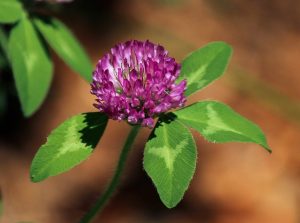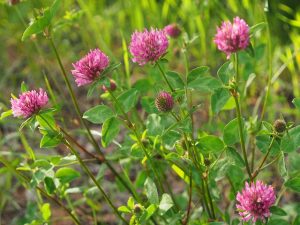(Trifolium pratense)
Red clover is a native plant that is often used as a pasture crop. Red clover is a healthy and nutritious plant, and all parts are edible. However, it is the blossoms that are the tastiest part, and the stems and leaves can be rather bitter.
Red clover can be found growing in grassy areas throughout many regions of the world.
 What does Red Clover look like?
What does Red Clover look like?
Red clover leave are small and oval shaped, with a light coloured ‘v’ shape pattern on them. The flowers grow in clusters of small florets, ranging from pink to red in colour. Red clover blossoms from May to October.
How to eat Red Clover
There are lots of ways to enjoy eating red clover. The easiest is to sprinkle the flowers over salads. Red clover blossom should be picked when fresh. Old blossoms that are becoming discoloured should be avoided.
 You can make a red clover flower infusion by steeping them in hot water for a couple of hours, then strain and drink the water once cooled.
You can make a red clover flower infusion by steeping them in hot water for a couple of hours, then strain and drink the water once cooled.
The leaves can be juiced and added to a healthy smoothie.
Considerations when eating Red Clover
Some people are allergic to red clover, so try tiny amounts first to test your tolerance.
Only eat red clover when it is fresh or dried. Do not use in any fermentation processes. When red clover ferments, it produces a blood thinning chemical that could potentially be harmful to health.
Although red clover is beneficial to health in lots of ways, do not consume too regularly. Red clover has been shown to affect estrogen levels in women, so this could affect hormonal balance if consumed daily. Do not consume red clover if you are pregnant or breast feeding.
Do you forage for red clover? How does it have a positive effect on your health?
Back to list of wild edible foods




